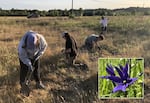
A group of people led by Joe Scott, a Siletz tribal member, dig for camas in a field outside of Eugene, Ore., on June 21, 2023. A camas with its flower intact is shown in the inset.
KLCC / Oregon State University
A prized plant for regional Native Americans has been carefully cultivated for more than 3,500 years, according to an Oregon State University study.
Camas is a First Foods staple for Native Americans, who traditionally baked the bulbs in earthen ovens.
Molly Carney is an assistant professor of anthropology at OSU, and lead author on the study. She looked at bulbs from around 3,500 years ago, and saw Native gatherers were harvesting them selectively.
“We found by looking at the archaeological bulbs, that people were only harvesting these sexually-mature plants,” said Carney. “And we infer that they are replanting the immature plants that are popped out with those bulbs.”
Camas becomes harvest-ready in three to five years, so Carney says this selective gathering shows careful stewardship of the plant. The study is published in the journal, Holocene.
In a release, OSU says these findings add to a growing body of research around what’s commonly called Traditional Ecological Knowledge (TEK), sustainable practices carried out by Indigenous people across North America for millennia.
“Camas is an ecological and cultural keystone, meaning it is a species that many other organisms depend on and that features prominently within many cultural practices,” the release said.

Molly Carney of OSU holds a metal version of a traditional digging stick, given to her by members of the Kalispel Tribe. This design is preferred over many other digging tools, as it's less apt to split the camas bulb.
Still from Oregon State University video
“If you think about salmon as being a charismatic species that people are very familiar with, camas is kind of the plant equivalent,” Carney added. “It is one of those species that really holds up greater ecosystems, a fundamental species which everything is related to.”
It takes two to three days of baking for camas bulbs to become softer and edible. The taste has been compared to something close to a sweet potato or other starchy root plants.
Camas baking ovens from 4400 years ago were recorded at a Long Tom River archaeological site near Veneta, but the OSU release said for several thousand years, the bulbs appeared to have been harvested somewhat indiscriminately.
“This timing in the Late Holocene period lines up with broader climatic shifts in the region, the researchers noted, coming around the same time as low-magnitude fires became more commonplace in the landscape,” OSU said.
Carney also studied evidence from the floor of Beaver Lake, collected by Central Washington University researcher Megan Walsh, that supported the theory that controlled burns were used to create optimal conditions for camas and other plants starting 3,000 to 4,000 years ago.
“The shift from haphazard harvesting to selective stewardship among tribal communities appears to have occurred at approximately the same time throughout the Pacific Northwest,” Carney said.
Researchers say for the practice to be successful, it would have required community-wide agreement to leave camas bulbs in the soil until the optimal harvest point, as well as conducting cultural burns to maintain healthy growing spaces.
The study’s co-author was Thomas Connolly from the Museum of Natural and Cultural History at the University of Oregon. The Confederated Tribes of Grand Ronde Historic Preservation Office approved the project.